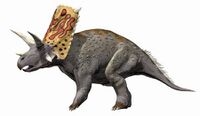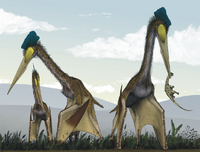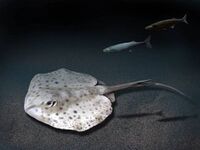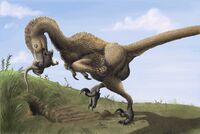Earth:Javelina Formation
| Javelina Formation Stratigraphic range: Maastrichtian, 70–66.5 Ma | |
|---|---|
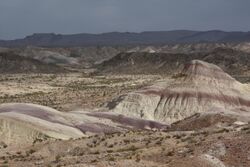 Distinctive mauve and red beds of the Javelina Formation outcropping in Big Bend National Park, Texas | |
| Type | Geological formation |
| Unit of | Tornillo Group |
| Underlies | Black Peaks Formation |
| Overlies | Aguja Formation |
| Lithology | |
| Primary | Sandstone |
| Other | Claystone, mudstone, siltstone, conglomerate |
| Location | |
| Coordinates | [ ⚑ ] : 29°18′N 103°24′W / 29.3°N 103.4°W |
| Paleocoordinates | [ ⚑ ] 36°00′N 82°48′W / 36.0°N 82.8°W |
| Region | |
| Country | |
| Type section | |
| Named for | Javelina |
| Lua error in Module:Location_map/multi at line 27: Unable to find the specified location map definition: "Module:Location map/data/Texas" does not exist. | |
The Javelina Formation is a geological formation in Texas. Dating has shown that the strata date to the Maastrichtian stage of the Late Cretaceous, approximately 70 to 66.5 million years old.[1] The middle part of the formation has been dated to about 69 million years ago plus or minus 1 million years and the top situated near the Cretaceous–Paleogene boundary (in the overlying Black Peaks Formation[1]), dated to 66 Ma ago.[2] Dinosaur remains are among the fossils that have been recovered from the formation.[3]
Age
The typical age range of the Javelina Formation has been difficult to determine.[4] Only one geological site in the Javelina Formation has thus far yielded the correct rock types for radiometric dating. The outcrop, situated in the middle strata of the formation about 90 meters below the K-Pg boundary and within the local range of Alamosaurus fossils and below two sites that have yielded Quetzalcoatlus fossils, was dated to 69.0 plus or minus 0.9 million years old in 2010.[2] Indeterminate chasmosaurinae fossils have also been as well.[5]
Fossil content
Vertebrate paleofauna
| Vertebrates of the Javelina Formation | ||||||
|---|---|---|---|---|---|---|
| Genus | Species | Location | Stratigraphic position | Material | Notes | Images |
| Alamosaurus | A. sanjuanensis | A titanosaurian sauropod, also from the Ojo Alamo Formation | ||||
| Bravoceratops | B. polyphemus | A chasmosaurine ceratopsid known from the lowermost part of the Javelina Formation which dates back to the early Maastrichtian.[6] | ||||
| Dasyatis[7] | Unknown | A ray | ||||
| Gryposaurus?[8] | G.? alsatei[8] | A saurolophine hadrosaurid known from the Two Medicine Formation, the Dinosaur Park Formation, the Kaiparowits Formation, possible remains have also been unearthed in the El Picacho Formation.[9] | ||||
| Kritosaurus[8][10] | K. navajovius[8][11][12] | A saurolophine handrosaurid, also known from the Kirtland Formation, Aguja Formation, Ojo Alamo Formation and the El Picacho Formation. A possible second species of Kritosaurus might have lived in the Javelina Formation. | ||||
| Quetzalcoatlus | Q. northropi and Q. lawsoni[13] | An azhdarchid pterosaur | ||||
| Rhombodus[7] | Unknown | A ray | ||||
| Saurornitholestes[14] | S. cf. langstoni | A dromaeosaurid | ||||
| Saurolophinae[8] | Indeterminate[8] | A saurolophine handrosaurid similar to the genus Saurolophus. | ||||
| Torosaurus[15] | T. utahensis[15] | A chasmosaurine ceratopsid whose remains have been found in the Frenchman Formation, Hell Creek Formation, North Horn Formation, McRae Formation, and Lance Formation. | ||||
| Troodon | T. sp. | A troodontid | ||||
| Tyrannosaurus | T. rex | A tyrannosaurid, originally identified from the Hell Creek Formation. Also found in the Denver, Ferris, Frenchman, Lance, Livingston, North Horn, Scollard, and Willow Creek Formations. |  [16] [16]
| |||
| Trionychidae | Indeterminate | Indeterminate turtle remains | ||||
| Wellnhopterus[13] | W. brevirostris | An azhdarchid pterosaur. | ||||
Flora
Woody dicots and angiosperms have been unearthed in this formation.[17][18] Plant fossils indicate that this area was a woodland habitat.[19]
| Flora of the Javelina Formation | ||||||
|---|---|---|---|---|---|---|
| Genus | Species | Location | Stratigraphic position | Material | Notes | Images |
| Javelinoxylon[20] | J. multiporosum[21] | A dicotyledonous tree | ||||
See also
- List of dinosaur-bearing rock formations
- List of fossiliferous stratigraphic units in Texas
- Paleontology in Texas
- Corsicana Marl
- El Picacho Formation
- Escondido Formation
- Kemp Clay
- Nacatoch Sand
- Neylandville Marl
References
- ↑ 1.0 1.1 Woodward, H. N. (2005). Bone histology of the sauropod dinosaur Alamosaurus sanjuanensis from the Javelina Formation, Big Bend National Park, Texas.
- ↑ 2.0 2.1 Lehman, T.M.; McDowell, F.; Connelly, J. (2006). "First isotopic (U-Pb) age for the Late Cretaceous Alamosaurus vertebrate fauna of West Texas, and its significance as a link between two faunal provinces". Journal of Vertebrate Paleontology 26 (4): 922–928. doi:10.1671/0272-4634(2006)26[922:fiuaft2.0.co;2].
- ↑ Weishampel, David B; et al. (2004). "Dinosaur distribution (Late Cretaceous, North America)." In: Weishampel, David B.; Dodson, Peter; and Osmólska, Halszka (eds.): The Dinosauria, 2nd, Berkeley: University of California Press. Pp. 574-588. ISBN:0-520-24209-2.
- ↑ Sullivan, R.M.; Lucas, S.G. (2006). "The Kirtlandian land-vertebrate "age" – faunal composition, temporal position and biostratigraphic correlation in the nonmarine Upper Cretaceous of western North America". New Mexico Museum of Natural History and Science, Bulletin 35: 7–29. http://www.nmnaturalhistory.org/science/bulletins/35/sci_bulletin35_2.pdf.[yes|permanent dead link|dead link}}]
- ↑ Hunt, ReBecca (September 2005). "CERATOPSID DINOSAURS FROM THE JAVELINA FORMATION (MAASTRICHTIAN), BIG BEND NATIONAL PARK, TEXAS". Journal of Vertebrate Paleontology 25 (3): 72A. https://www.researchgate.net/publication/298236308. Retrieved 27 November 2020.
- ↑ Wick, Steven L.; Lehman, Thomas M. (1 July 2013). "A new ceratopsian dinosaur from the Javelina Formation (Maastrichtian) of West Texas and implications for chasmosaurine phylogeny". Naturwissenschaften 100 (7): 667–682. doi:10.1007/s00114-013-1063-0. PMID 23728202. Bibcode: 2013NW....100..667W. https://pubmed.ncbi.nlm.nih.gov/23728202/. Retrieved 27 November 2020.
- ↑ 7.0 7.1 Hunt, ReBecca K.; Santucci, Vincent L.; Kenworthy, Jason (2006). "A preliminary inventory of fossil fish from National Park Service units." in S.G. Lucas, J.A. Spielmann, P.M. Hester, J.P. Kenworthy, and V.L. Santucci (ed.s), Fossils from Federal Lands". New Mexico Museum of Natural History and Science Bulletin 34: 63–69.
- ↑ 8.0 8.1 8.2 8.3 8.4 8.5 Lehman, Thomas M.; Wick, Steven L.; Wagner, Jonathan R. (2016). "Hadrosaurian dinosaurs from the Maastrichtian Javelina Formation, Big Bend National Park, Texas". Journal of Paleontology 90 (2): 1–24. doi:10.1017/jpa.2016.48. Bibcode: 2016JPal...90..333L.
- ↑ Osmólska, Halszka; Dobson, Peter; Weishampel, David B. (6 November 2004). The Dinosauria. Berkeley, CA: University of California Press. p. 582. ISBN 9780520242098. https://books.google.com/books?id=h4WRTHfTzXsC.
- ↑ Wagner, Jonathan R. (May 2001). The hadrosaurian dinosaurs (ornithischia: hadrosauria) of Big Bend National Park, Brewster County, Texas, with implications for late Cretaceous paleozoogeography. Doctoral Dissertation, Texas Tech University (Thesis). hdl:2346/11160. Retrieved 24 October 2020.
- ↑ Wagner, Jonathan R. (May 2001). The hadrosaurian dinosaurs (ornithischia: hadrosauria) of Big Bend National Park, Brewster County, Texas, with implications for late Cretaceous paleozoogeography. Doctoral Dissertation, Texas Tech University (Thesis). hdl:2346/11160. Retrieved 24 October 2020.
- ↑ Wagner, Jonathan R.; Lehman, Thomas M. (2001). "A new species of Kritosaurus from the Cretaceous of Big Bend National Park, Brewster County, Texas". Journal of Vertebrate Paleontology 21 (3): 110A–111A.
- ↑ 13.0 13.1 Andres, B.; Langston, W. Jr. (2021). "Morphology and taxonomy of Quetzalcoatlus Lawson 1975 (Pterodactyloidea: Azhdarchoidea)". Journal of Vertebrate Paleontology 41 (sup1): 142. doi:10.1080/02724634.2021.1907587. ISSN 0272-4634. Bibcode: 2021JVPal..41S..46A.
- ↑ Sankey, J. T.; Standhardt, B. R.; Schiebout, J. A. (2005). Theropod teeth from the Upper Cretaceous (Campanian-Maastrichtian), Big Bed National Park, Texas. In K. Carpenter (ed.), The Carnivorous Dinosaurs. Indiana University Press, Bloomington. pp. 127–152.
- ↑ 15.0 15.1 Hunt, ReBecca K.; Lehman, Thomas M. (2008). "Attributes of the ceratopsian dinosaur Torosaurus, and new material from the Javelina Formation (Maastrichtian) of Texas". Journal of Paleontology 82 (6): 1127–1138. doi:10.1666/06-107.1. Bibcode: 2008JPal...82.1127H.
- ↑ Wick, Steven L. (July 2014). "New evidence for the possible occurrence of Tyrannosaurus in West Texas, and discussion of Maastrichtian tyrannosaurid dinosaurs from Big Bend National Park". Cretaceous Research 50: 52–58. doi:10.1016/j.cretres.2014.03.010. Bibcode: 2014CrRes..50...52W. https://www.sciencedirect.com/science/article/abs/pii/S0195667114000500. Retrieved 27 November 2020.
- ↑ Wheeler, Elisabeth A.; Lehman, Thomas M. (1 January 2000). "Late Cretaceous woody dicots from the Aguja and Javelina Formations, BiBend National Park, Texas, USA.". IAWA Journal 21 (1): 83–120. doi:10.1163/22941932-90000239. https://brill.com/view/journals/iawa/21/1/article-p83_7.xml. Retrieved 24 October 2020.
- ↑ Lehman, Thomas M.; Shiller II, Thomas A. (2020). "An angiosperm woodland in the Javelina Formation (Upper Cretaceous), Big Bend National Park, Texas, U.S.A.". Cretaceous Research 115: 104569. doi:10.1016/j.cretres.2020.104569. Bibcode: 2020CrRes.11504569L. https://www.sciencedirect.com/science/article/pii/S019566712030255X. Retrieved 24 October 2020.
- ↑ Lehman, Thomas M.; Shiller II, Thomas A. (2020). "An angiosperm woodland in the Javelina Formation (Upper Cretaceous), Big Bend National Park, Texas, U.S.A.". Cretaceous Research 115: 104569. doi:10.1016/j.cretres.2020.104569. Bibcode: 2020CrRes.11504569L. https://www.sciencedirect.com/science/article/pii/S019566712030255X. Retrieved 24 October 2020.
- ↑ Jacobs, L. 1995. Lone Star Dinosaurs. Texas A&M University Press. p.102
- ↑ Wheeler, E. A.; Lehman, T. M.; Gasson, P. E. (1994). "Javelinoxylon, an Upper Cretaceous dicotyledonous tree from Big Bend National Park, Texas, with presumed Malvalean affinities". American Journal of Botany 81 (6): 703–710. doi:10.1002/j.1537-2197.1994.tb15504.x.
Further reading
- S. L. Wick and T. M. Lehman. 2013. A new ceratopsian dinosaur from the Javelina Formation (Maastrichtian) of West Texas and implications for chasmosaurine phylogeny. Naturwissenschaften
- T. M. Lehman and A. B. Coulson. 2002. A juvenile specimen of the sauropod dinosaur Alamosaurus sanjuanensis from the Upper Cretaceous of Big Bend National Park, Texas. Journal of Paleontology 76(1):156-172
- A. R. Fiorillo. 1998. Preliminary report on a new sauropod locality in the Javelina Formation (Late Cretaceous), Big Bend National Park, Texas. In V. L. Santucci & L. McClelland (eds.), National Park Service Geologic Resources Division Technical Report NPS/NRGRD/GRDTR-98/01. National Park Service Paleontological Research Volume 3:29-31
- A. W. A. Kellner and W. Langston. 1996. Cranial remains of Quetzalcoatlus (Pterosauria, Azhdarchidae) from Late Cretaceous sediments of Big Bend National Park, Texas. Journal of Vertebrate Paleontology 16(2):222-231
- D. A. Lawson. 1976. Tyrannosaurus and Torosaurus, Maestrichtian dinosaurs from Trans-Pecos, Texas. Journal of Paleontology 50(1):158-164
- D. A. Lawson. 1975. Pterosaur from the latest Cretaceous of West Texas: discovery of the largest flying creature. Science 187:947-948
 |

